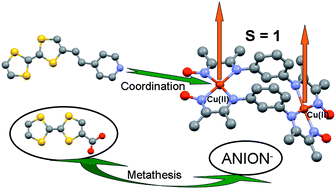A new approach towards ferromagnetic conducting materials based on TTF-containing polynuclear complexes†‡
Abstract
Five complexes containing binuclear cation

- This article is part of the themed collection: Advanced Hybrid Materials
* Corresponding authors
a L. V. Pisarzhevskii Institute of Physical Chemistry of the National Academy of Sciences of the Ukraine, Prospekt Nauki 31, Kiev, Ukraine
b
Equipe Organométalliques et Matériaux Moléculaires, Sciences Chimiques de Rennes, UMR UR1-CNRS 6226, Université de Rennes 1, Campus de Beaulieu, Rennes cedex, France
E-mail:
lahcene.ouahab@univ-rennes1.fr
Fax: +33 (0)2 23 23 68 40
Tel: +33 (0)2 23 23 56 59
Five complexes containing binuclear cation

 Please wait while we load your content...
Something went wrong. Try again?
Please wait while we load your content...
Something went wrong. Try again?
S. V. Kolotilov, O. Cador, F. Pointillart, S. Golhen, Y. Le Gal, K. S. Gavrilenko and L. Ouahab, J. Mater. Chem., 2010, 20, 9505 DOI: 10.1039/B925178B
To request permission to reproduce material from this article, please go to the Copyright Clearance Center request page.
If you are an author contributing to an RSC publication, you do not need to request permission provided correct acknowledgement is given.
If you are the author of this article, you do not need to request permission to reproduce figures and diagrams provided correct acknowledgement is given. If you want to reproduce the whole article in a third-party publication (excluding your thesis/dissertation for which permission is not required) please go to the Copyright Clearance Center request page.
Read more about how to correctly acknowledge RSC content.
 Fetching data from CrossRef.
Fetching data from CrossRef.
This may take some time to load.
Loading related content
